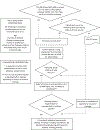American Cochlear Implant Alliance Task Force: Recommendations for Determining Cochlear Implant Candidacy in Adults
- PMID: 37435829
- PMCID: PMC10914083
- DOI: 10.1002/lary.30879
American Cochlear Implant Alliance Task Force: Recommendations for Determining Cochlear Implant Candidacy in Adults
Abstract
The indications for cochlear implantation have expanded over time due to evidence demonstrating identification and implantation of appropriate cochlear implant (CI) candidates lead to significant improvements in speech recognition and quality of life (QoL). However, clinical practice is variable, with some providers using outdated criteria and others exceeding current labeled indications. As a results, only a fraction of those persons who could benefit from CI technology receive it. This document summarizes the current evidence for determining appropriate referrals for adults with bilateral hearing loss into CI centers for formal evaluation by stressing the importance of treating each ear individually and a "revised 60/60 rule". By mirroring contemporary clinical practice and available evidence, these recommendations will also provide a standardized testing protocol for CI candidates using a team-based approach that prioritizes individualized patient care. This manuscript was developed by the Adult Cochlear Implantation Candidacy Task Force of the American Cochlear Implant Alliance using review of the existing literature and clinical consensus. LEVEL OF EVIDENCE: N/A Laryngoscope, 134:S1-S14, 2024.
Keywords: adult; candidacy; cochlear implant; evidence; protocol; recommendation.
© 2023 The American Laryngological, Rhinological and Otological Society, Inc.
Conflict of interest statement
The authors have no other funding, financial relationships, or conflicts of interest to disclose.
Figures
Similar articles
-
American Cochlear Implant Alliance Task Force Guidelines for Determining Cochlear Implant Candidacy in Children.Ear Hear. 2022 Mar/Apr;43(2):268-282. doi: 10.1097/AUD.0000000000001087. Ear Hear. 2022. PMID: 35213891 Free PMC article.
-
American Cochlear Implant Alliance Task Force Guidelines for Clinical Assessment and Management of Adult Cochlear Implantation for Single-Sided Deafness.Ear Hear. 2022 Nov-Dec 01;43(6):1605-1619. doi: 10.1097/AUD.0000000000001260. Epub 2022 Aug 22. Ear Hear. 2022. PMID: 35994570 Free PMC article.
-
Assessment of Cochlear Implants for Adult Medicare Beneficiaries Aged 65 Years or Older Who Meet Expanded Indications of Open-Set Sentence Recognition: A Multicenter Nonrandomized Clinical Trial.JAMA Otolaryngol Head Neck Surg. 2020 Oct 1;146(10):933-941. doi: 10.1001/jamaoto.2020.2286. JAMA Otolaryngol Head Neck Surg. 2020. PMID: 32857106 Free PMC article. Clinical Trial.
-
Evidence for the expansion of pediatric cochlear implant candidacy.Otol Neurotol. 2015 Jan;36(1):43-50. doi: 10.1097/MAO.0000000000000607. Otol Neurotol. 2015. PMID: 25275867
-
Expansion of Audiologic Criteria for Pediatric Cochlear Implantation.Otolaryngol Clin North Am. 2021 Dec;54(6):1181-1191. doi: 10.1016/j.otc.2021.08.002. Otolaryngol Clin North Am. 2021. PMID: 34774230 Free PMC article. Review.
Cited by
-
Brazilian Society of Otology task force - cochlear implant ‒ recommendations based on strength of evidence.Braz J Otorhinolaryngol. 2025 Jan-Feb;91(1):101512. doi: 10.1016/j.bjorl.2024.101512. Epub 2024 Sep 16. Braz J Otorhinolaryngol. 2025. PMID: 39442262 Free PMC article. Review.
-
Cochlear implant procedure. Italian Clinical Practice Guidelines of the Italian Society of Otorhinolaryngology (SIOeChCF) and Italian Society of Audiology and Phoniatrics (SIAF). Part 1: cochlear implants in adults.Acta Otorhinolaryngol Ital. 2025 Feb;45(1):47-57. doi: 10.14639/0392-100X-N3081. Acta Otorhinolaryngol Ital. 2025. PMID: 40099446 Free PMC article.
-
Cochlear Implantation: Long-Term Effect of Early Activation on Electrode Impedance.J Clin Med. 2024 Jun 3;13(11):3299. doi: 10.3390/jcm13113299. J Clin Med. 2024. PMID: 38893010 Free PMC article.
-
Utilization of the Spanish Bisyllable Word Recognition Test to Assess Cochlear Implant Performance Trajectory.J Clin Med. 2025 Jan 24;14(3):774. doi: 10.3390/jcm14030774. J Clin Med. 2025. PMID: 39941445 Free PMC article.
-
Access to Cochlear Implantation: Trends in Surgeon Volume and Training.Laryngoscope. 2025 Jun;135(6):2146-2153. doi: 10.1002/lary.32037. Epub 2025 Feb 11. Laryngoscope. 2025. PMID: 39932075 Free PMC article.
References
-
- Deafness and hearing loss. https://www.who.int/news-room/fact-sheets/detail/deafness-and-hearing-loss. Accessed June 23, 2021.
-
- Li-Korotky HS. Age-related hearing loss: Quality of care for quality of life. Gerontologist. 2012;52(2):265–271. - PubMed
-
- Nassiri AM, Sorkin DL, Carlson ML. Current Estimates of Cochlear Implant Utilization in the United States. Otology & neurotology. 2022;43(5):e558–e562. - PubMed
-
- What Are Cochlear Implants for Hearing? | NIDCD. https://www.nidcd.nih.gov/health/cochlear-implants. Accessed June 23, 2021.
Publication types
MeSH terms
Grants and funding
LinkOut - more resources
Full Text Sources
Medical
Research Materials



